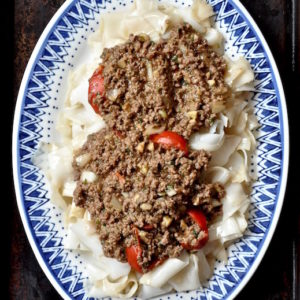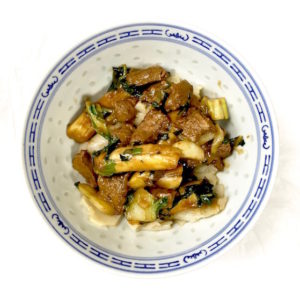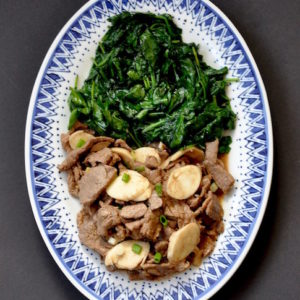Beef Rendang
Rendang daging sapi, or beef rendang, is a specialty of West Sumatra. Rendangs are dry curries, not loose affairs you pour over noodles or rice.

While beef rendang begins as wet curries do, with copious amounts of coconut milk, it diverges in cooking method. Prepared in a wide, shallow pan instead of a deep pot, beef rendang cooks ever so slowly from a bright yellow pool of food down to an oily puddle of what Crayola calls “burnt sienna.” The resulting dish is far from photogenic, but it is deeply flavorful.

Photogenic spice paste.
Every twenty minutes or so, you must stir. If you’re me, you may worry. Is it possible all that liquid will bubble down to nothing?

This terrible cell phone photograph depicts beef rendang at the start of cooking. Fast forward three hours to another bad cell phone photograph….

Lo, reduction.
The upshot? Be patient.

As the coconut milk reaches the final moments of cooking, you must attend closely, lest your finally tender beef scorch or stick.
 IRendang is not set it and forget it food. It is, however, well worth the comparatively minor effort.
IRendang is not set it and forget it food. It is, however, well worth the comparatively minor effort.
How spicy is beef rendang? James Oseland’s recipe gives a range of hot peppers: the timid may try five, the bold, twenty. As Mr. IK does not share my volcanic proclivities, I used four admittedly fiery Thai red peppers in the dish…and added a few more at the table.

After years of struggling to achieve a reasonable balance between “gentle simmer” and “crazed boil” on my stove, Tane Chan of The Wok Shop pressed a flame tamer into my hands. Yet another reason to visit the Wok Shop, either online or in person.

As beef rendang is extremely rich, I served it with plain steamed rice and stir-fried bok choy.

Beef rendang improves with age, reaching peak flavor on day three.

A final note: Anyone interested in learning more about Indonesian cooking will enjoy Oseland’s award-winning Cradle Of Flavor or any of Sri Owen’s books.
—
Beef Rendang
with very minor adaptations from James Oseland’s Cradle Of Flavor
serves 2-4
Preparation and cooking time: There’s some slicing, grinding, and chopping involved before beef rendang is placed on the stove to cook for 2-3 hours. Beef rendang cannot be rushed. Make it on a day you’ll be home doing other tasks.
You will need either a mortar and pestle or food processor to cook this recipe. A flame tamer is useful but not essential; this inexpensive gadget is sold at most hardware stores.
Beef rendang should be cooked in a wide, shallow pot to allow maximum evaporation. A heavy 12-inch nonstick frying pan, saucier, or comparable pan would work. I used my Staub “Everyday” pan, which measures 9 inches across and 3 inches deep.
For the spice paste:
1 whole nutmeg, crushed (use a mortar and pestle or the bottom of a heavy glass)
5 whole cloves
6 shallots, peeled and roughly chopped
3 garlic cloves, peeled and roughly chopped
4-20 fresh red chile peppers, stemmed and roughly chopped (Thai, Fresno, or cayenne)
1 1/2 teaspoons ground turmeric
1 piece fresh ginger, about two inches long, peeled and thinly sliced against the grain
1 piece fresh galangal, about two inches long, peeled and thinly sliced against the grain (optional)
5 unsalted macadamia nuts (see notes)
For the beef rendang:
1 1/2-2 pounds well-marbled boneless beef chuck or bottom round, cut into 2 inch cubes
2 1/2 cups unsweetened coconut milk
3 stalks lemongrass, peeled down to soft portions and tied into a knot
or
1 small lemon, cut into quarters (see notes)
1 four-inch long cinnamon stick
7 kaffir lime leaves (see notes)
1 teaspoon fine sea or kosher salt
Begin by preparing the spice paste. Crushed the nutmeg with a mortar and pestle or spice grinder. Add the cloves. Grind to a fine powder.
Tip the nutmeg/clove powder into a food processor fitted with the steel blade. Add the shallot, garlic, chiles, turmeric, ginger, galangal, and macadamia nuts. Process mixture until it resembles lumpy polenta. If using galangal, be sure to cut into small pieces before adding to processor, as larger chunks tend to catch on processor blades.
Set flame tamer over a burner if using. Place the pan over medium heat. Add spice paste and cubed beef; stir to combine. Add coconut milk, lemongrass or lemon quarters, cinnamon stick, lime leaves, and salt. Stir to combine.
Turn heat up to gentle boil. If using flamer tamer, this will take longer, but it will happen. Once the beef rendang reaches a low boil, reduce heat to medium-low simmer. Stir.
Maintain the simmer and stir every 20 minutes or so, cooking for the next 2-3 hours. Initially you may not believe all that coconut milk will cook down. It will.
Depending on your stove, pot, and the food itself, the reduction process will take up to 3 hours. Eventually coconut milk will reduce to nearly nothing, darkening to a deep brown. The oils from the coconut milk will separate a bit. You can pour this off or just stir to incorporate; I found it easiest to stir into the dish. Beef will be fork tender and fragile; stir carefully to avoid breaking it up. When the coconut milk is evaporated and beef is color of dark coffee, the dish is ready.
You can remove the lime leaves, cinnamon stick, and lemongrass from the pan–in fact, I found it necessary, as they interfered with stirring as the coconut milk cooked down–or leave for diners to remove at table.
Beef rendang will improve tremendously if you allow it to rest in the refrigerator 1-3 days. Serve warm rather than hot.
Traditionally beef rendang is served with other curries. As it is so rich, I paired it with plain steamed rice and stir-fried bok choy. Oseland suggests serving additional shredded lime leaves at table.
While you could freeze beef rendang, it is not advisable as the subtle flavors would be lost.
Notes:
Oseland’s recipe suggests using candlenuts, which cause mild nausea if consumed raw. Macadamia nuts are a useful suggested alternative.
In Cradle Of Flavor, James Oseland explains the Indonesian cooking technique of tying lemongrass in a knot, infusing dishes with flavor without overwhelming them. This requires lemongrass fresh enough to be flexible, something I’ve never encountered. I’m happy to pull the fibrous outer layers off and simply chop up the soft bits. In this instance, having run out of lemongrass–talk about first world problems!–I quartered a small Meyer lemon and tossed it into the pan. It dissolved over the hours of cooking.
Kaffir lime leaves are sold in Asian markets and in some upscale markets. They freeze well, so buy them in bulk when you find them.
 The photo of “Patience” comes from the Guns N’Roses “Lies” compact disc.
The photo of “Patience” comes from the Guns N’Roses “Lies” compact disc.




